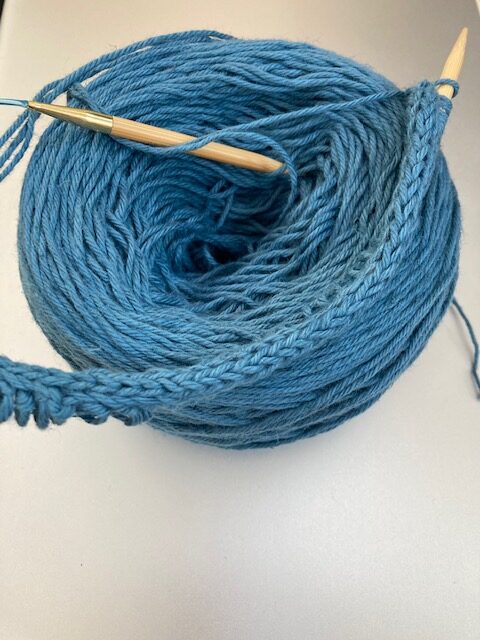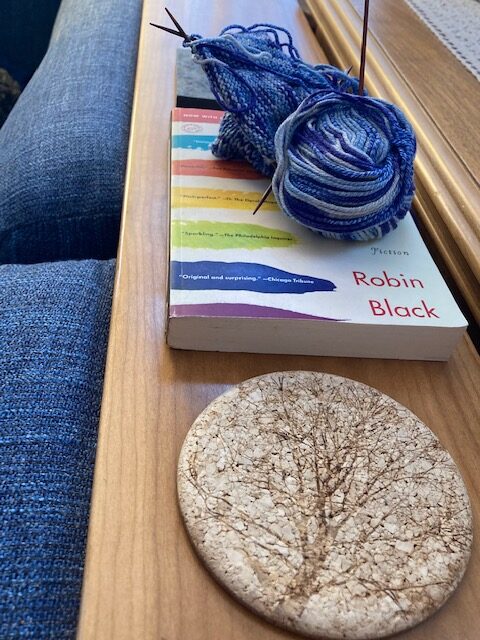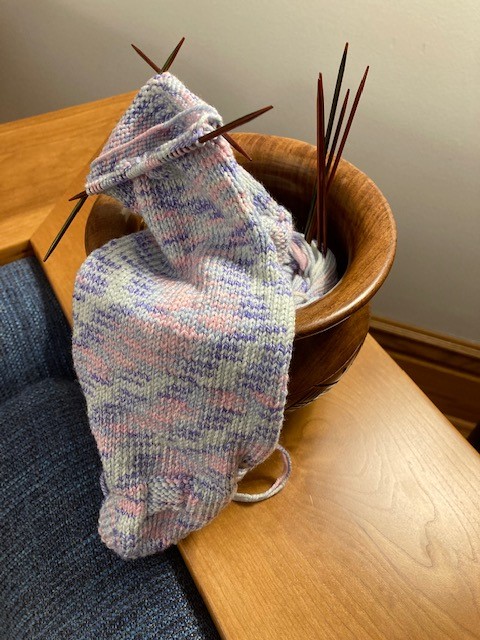
Thanks to Northfield Yarn and their invaluable knitting clinic for giving me the courage to tackle another sweater (my second). Here, you see the beginning of the “corded cast-on” or what will someday be the neckline of a cotton and linen sweater.



Thanks to Northfield Yarn and their invaluable knitting clinic for giving me the courage to tackle another sweater (my second). Here, you see the beginning of the “corded cast-on” or what will someday be the neckline of a cotton and linen sweater.


As many of you know, for some years I have been knitting socks. I had wanted to learn how ever since I read this translation by Robert Bly of Pablo Neruda’s paean to homemade socks. I had learned how to knit in the round on slim bamboo needles from Vanessa Bodrie, who taught a knitting class for homeschooled students and their moms, but I was defeated from rendering a sock until another Northfielder, Kate Stuart, kindly (and very patiently) walked me through turning the heel and shaping the gusset.
(I would like to add that one-on-one instruction in knitting is the only way for me to progress, and that Northfield Yarn excels in this kind of tutoring for knitters at all levels–thanks to Cynthia Gilbertson’s Sweater Academy, I have actually knitted my first sweater and it fits! Still, socks are currently my comfort zone. I knit the same sock over and over with slight variations. And the best place I have found to discover new color and blends of sock yarns is Northfield Yarn.)
Handmade socks–for yourself or for another–are always a gift of love. And I think that beautiful things gain in beauty when they are used for their intended purposes, for then an ordinary day becomes enchanted. No one has captured the sheer magic of this better than Neruda, that controversial and passionate poet-statesman who won the Nobel Prize in Literature in 1971. I can’t read the work in its original Spanish, and I don’t know enough about the art of translation to weigh in on the controversy of Bly’s work as a translator, but, for me as a reader, this one works. It sings, and it has moved me to action over and over.
Pablo Neruda – 1904-1973
Maru Mori brought me
a pair
of socks
which she knitted herself
with her sheepherder’s hands,
two socks as soft
as rabbits.
I slipped my feet
into them
as though into
two
cases
knitted
with threads of
twilight
and goatskin.
Violent socks,
my feet were
two fish made
of wool,
two long sharks
sea-blue, shot
through
by one golden thread,
two immense blackbirds,
two cannons:
my feet
were honored
in this way
by
these
heavenly
socks.
They were
so handsome
for the first time
my feet seemed to me
unacceptable
like two decrepit
firemen, firemen
unworthy
of that woven
fire,
of those glowing
socks.
Nevertheless
I resisted
the sharp temptation
to save them somewhere
as schoolboys
keep
fireflies,
as learned men
collect
sacred texts,
I resisted
the mad impulse
to put them
into a golden
cage
and each day give them
birdseed
and pieces of pink melon.
Like explorers
in the jungle who hand
over the very rare
green deer
to the spit
and eat it
with remorse,
I stretched out
my feet
and pulled on
the magnificent
socks
and then my shoes.
The moral
of my ode is this:
beauty is twice
beauty
and what is good is doubly
good
when it is a matter of two socks
made of wool
in winter.
“Ode to My Socks” from Neruda & Vallejo: Selected Poems, by Pablo Neruda and translated by Robert Bly (Boston: Beacon Press, 1993).
For more on Pablo Neruda and Minnesota’s own Robert Bly, checks Poets.org or see the links here.
Regarding my poem for today, “Mulberries”: This poem (shared via email to those interested) is, in some ways, the inverse of the Neruda ode above. In that case, the poem triggered action in “the real world.” “Mulberries” describes a childhood encounter of the natural world that led to a kind of plein-air art-making and gave rise to a fascination with the history of this useful and astonishing plant, Morus alba, used for shade and fruit, to feed silk worms, and to make ethereal writing and gift-wrapping papers.

Happy Reading! Happy Writing! LESLIE